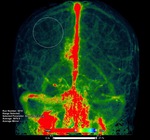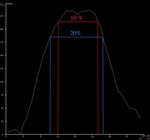Purpose
Endovascular treatment is a promising approach for early stroke therapy (1).
However selecting the right acute ischemic stroke patients eligible for revascularization therapy can be challenging (2).
Cerebral blood volume (CBV) anomalies are correlated to definitive lesions (3).
The extent of pre-intervention CBV abnormality is a strong predictor of functional outcomes following endovascular stroke therapy (4).
Advanced modality imaging evaluation in acute ischemic stroke may lead to delay in endovascular reperfusion therapy.
Sheth et al.
showed that stroke patients selected with non contrast CT scan...
Methods and Materials
Patient characteristics
Between May 2012 and January 2013,
24 patients (14 women,
10 men; age range,
19 - 84 years; median,
39 years) referred for endovascular treatment were prospectively enrolled for this study performed according to the guidelines of our institution,
informed consent was obtained for each procedure.
Perfusion study was acquired in the angiographic suite during 10 brain arteriovenous malformation endovascular treatments and 14 intracranial aneurysm flow-diverter stent-assisted treatments.
FPCT CBV measurement
Both endovascular treatment and perfusion study were performed on a biplan angiographic...
Results
Time intensity curves analyze was possible in every case.
20 patients were explored using central venous injections; 10 with the 72/72 protocol and 10 with the 72/20 protocol.
4 patients were explored using peripheral injections (Table 1).
Number of patients
Average age
Aneurysm / AVM
Central 72/72
10
46
7 / 3
Central 72/20
10
35
6 / 4
Peripheral 72/72
4
43
1 / 3
Table 1.
Injection protocols.
There were no statistical differences between mean peak values of the three different protocols (Central...
Conclusion
Steady state of contrast enhancement in brain parenchyma is required throughout acquisition time for correct FPCT CBV measurements.
With clinically acceptable contrast agent volumes,
steady state is a brief condition thus fast rotation speed acquisitions are needed.
The use of central venous injections decreases the variability of steady state’s delay from injection.
From this study it is possible to describe an examination protocol that does not require test injections anymore but that would not be suitable for all patients.
“Bolus watching” technique is an interesting...
References
1.
Taqi MA,
Vora N,
Callison RC,
Lin R,
Wolfe TJ.
Past,
present,
and future of endovascular stroke therapies.
Neurology.
2012 Sep 25;79(13 Suppl 1):S213-20.
2.
Shang T,
Yavagal DR.
Application of acute stroke imaging: Selecting patients for revascularization therapy.
Neurology.
2012 Sep 25;79(13 Suppl 1):S86-94.
3.
Murphy BD,
Fox AJ,
Lee DH,
Sahlas DJ,
Black SE,
Hogan MJ,
et al.
White matter thresholds for ischemic penumbra and infarct core in patients with acute stroke: CT perfusion study.
Radiology.
2008 Jun 1;247(3):818-25.
4.
Rai AT,...





